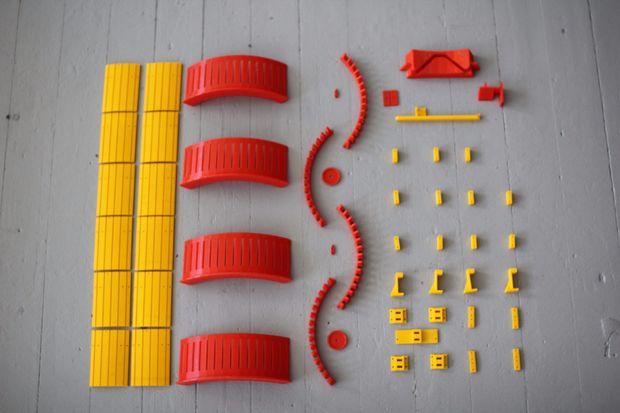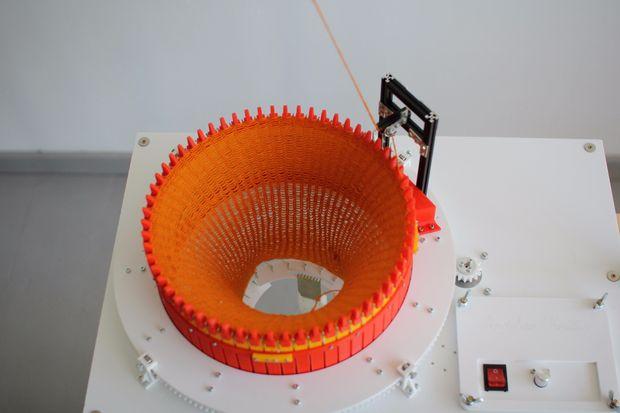Circular knitting, or knitting in the round, is a technique used to create seamless ‘tubes’ of knit material. Circular knitting can be done either on needles, double pointed or circular, or on a knitting machine. It is a very popular method for creating hats, socks, and sweaters among other knitted necessities. Knitting with the needles certainly has its appeal; it is somewhat meditative and soothing. The sound of the clicking needles, the movement of the yarn through your fingers, and watching a project build up, stitch by stitch, are all enjoyable parts of the process. However, using a knitting machine adds a super sized boost of speed that is also quite appealing.
 Inexpensive knitting machines for use by kids can be purchased for under $100, and more robust machines can range from several hundred to several thousand dollars. The process of knitting is reminiscent of that used in additive manufacturing, a filament (in this case yarn) is built up layer by layer into a 3 dimensional object…and the creation is only as good as the designer. In other words, it is a technology that doesn’t create on its own. The idea behind a circular knitting machine is that the building up of those layers can occur much more quickly, allowing the devoted knitter to spend more time designing, and/or prototyping their design.
Inexpensive knitting machines for use by kids can be purchased for under $100, and more robust machines can range from several hundred to several thousand dollars. The process of knitting is reminiscent of that used in additive manufacturing, a filament (in this case yarn) is built up layer by layer into a 3 dimensional object…and the creation is only as good as the designer. In other words, it is a technology that doesn’t create on its own. The idea behind a circular knitting machine is that the building up of those layers can occur much more quickly, allowing the devoted knitter to spend more time designing, and/or prototyping their design.
 The circular knitting machine and its capacity for rapid production made it an essential tool for the military during World War I when it was utilized to speed up the production of socks for the soldiers – a vital element of preventing trench foot. The appeal of the machine is fairly apparent and artists Mar Canet and Varvara Guljajeva wanted to contribute to its accessibility by creating their own open hardware machine. They called their creation the Circular Knitic. They explained:
The circular knitting machine and its capacity for rapid production made it an essential tool for the military during World War I when it was utilized to speed up the production of socks for the soldiers – a vital element of preventing trench foot. The appeal of the machine is fairly apparent and artists Mar Canet and Varvara Guljajeva wanted to contribute to its accessibility by creating their own open hardware machine. They called their creation the Circular Knitic. They explained:
“With the boom of digital fabrication technology, a 3D printer is gradually turning into a commodity that every creative studio has on their desk. At the same time, Fab Labs and makerspaces are a lot about hard-surfact object production while the first digital fabrication tool, an electronic knitting machine back in 1976, has been forgotten and discontinued. Hence, with this project, Circular Knitic, and our earlier one called Knitic, we aim to integrate textile fabrication to the makers’ culture.”
After all, it’s no coincidence that the root of the word ‘fabricate’ is ‘fabric.’
The project, which is detailed completely in an Instructables tutorial, requires laser cutting, 3D printing, basic woodworking, and comfort with electronics. There are 13 steps in total, to go from wish to completion, and a tutorial is included on how to cast on (the term used for starting the first stitch). The 3D print files are available for free download with the name of each file dictating how many copies need to be printed in order to create a complete machine. The creators add an emphatic note accentuating the need to print in high quality with a maximum 0.1 mm layer height.
There has been a hierarchy in making that has generally placed working with hard materials such as wood, plastic, glass, and metal at a higher level than working with soft goods. However, more makers are realizing the complexity and creativity required for the creation of textiles and other soft materials. As these have traditionally been conceived of in the West as feminine activities, they have all too often been ignored or denigrated as areas for creative expression. The creation of the Knitic helps to reintroduce the connection between all forms of making and makes a strong argument for the obvious relationship between 3D printing and knitting as methods of additive manufacturing.
What do you think of this clever creation? Discuss in the Knitic forum thread on 3DPB.com.
Subscribe to Our Email Newsletter
Stay up-to-date on all the latest news from the 3D printing industry and receive information and offers from third party vendors.
You May Also Like
3D Printing Unpeeled: Biofuel Waste to Filament & Sustainable Photopolymers
I can’t ever remember a day with so many potentially high impact news stories have come out. In one story, we all know that there are problems with the safety...
Finnair Hires AM Craft to 3D Print Plastic Parts for Aircraft Interiors
Riga-based AM Craft, a supplier specialized in 3D printing aviation components and certified under EASA Part 21G, announced a significant achievement today. The company will assist in upgrading Finnair’s A320...
3DPOD Episode 198: High Speed Sintering with Neil Hopkinson, VP of AM at Stratasys
Neil Hopkinson, a pioneering 3D printing researcher, played a pivotal role in developing a body of research that is widely utilized today. He also invented High Speed Sintering (HSS), also...
3D Printing Webinar and Event Roundup: May 12, 2024
Webinars and events are picking up in the AM industry this week! ASTM International continues its Professional Certificate Course and Stratasys continues its advanced in-person trainings, while 3D Systems is...


































